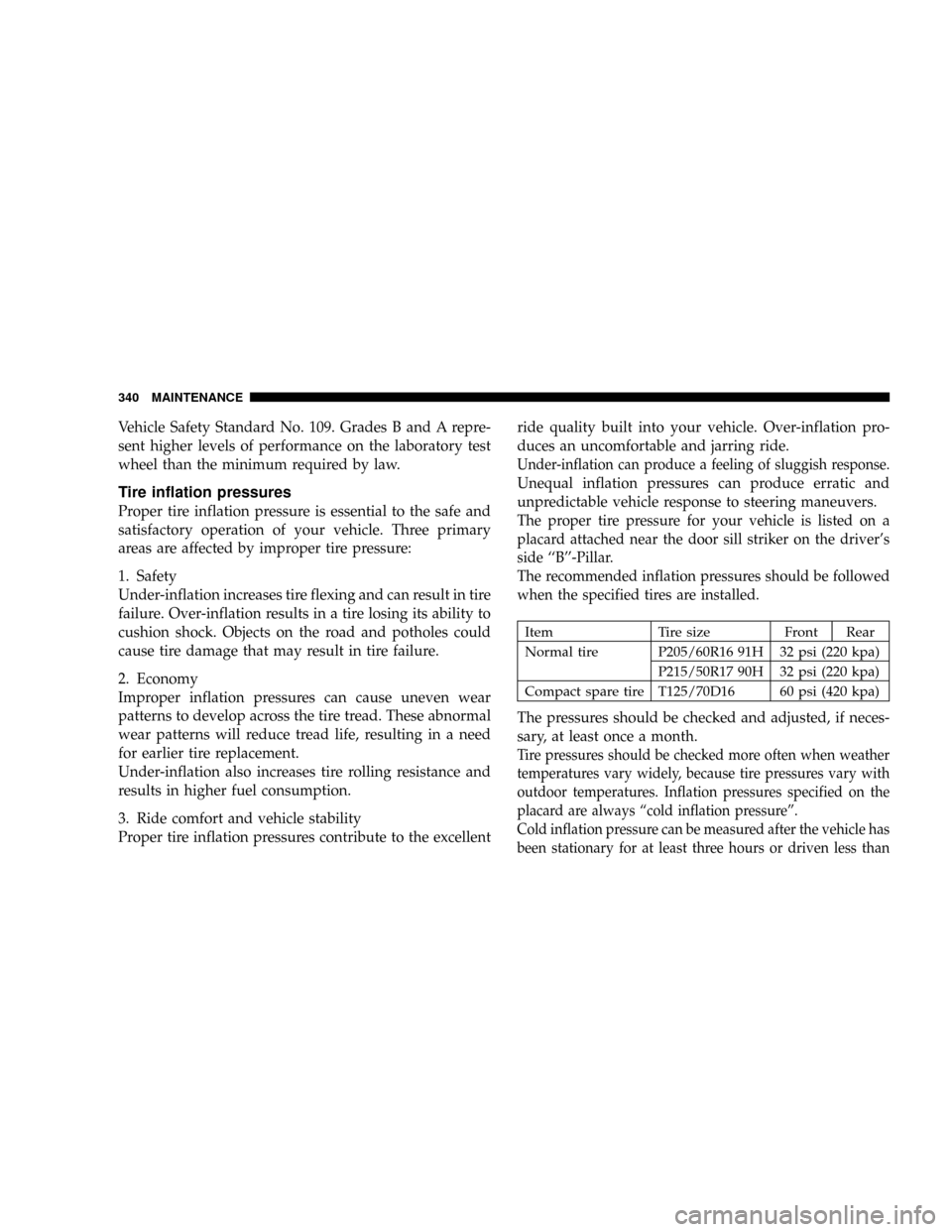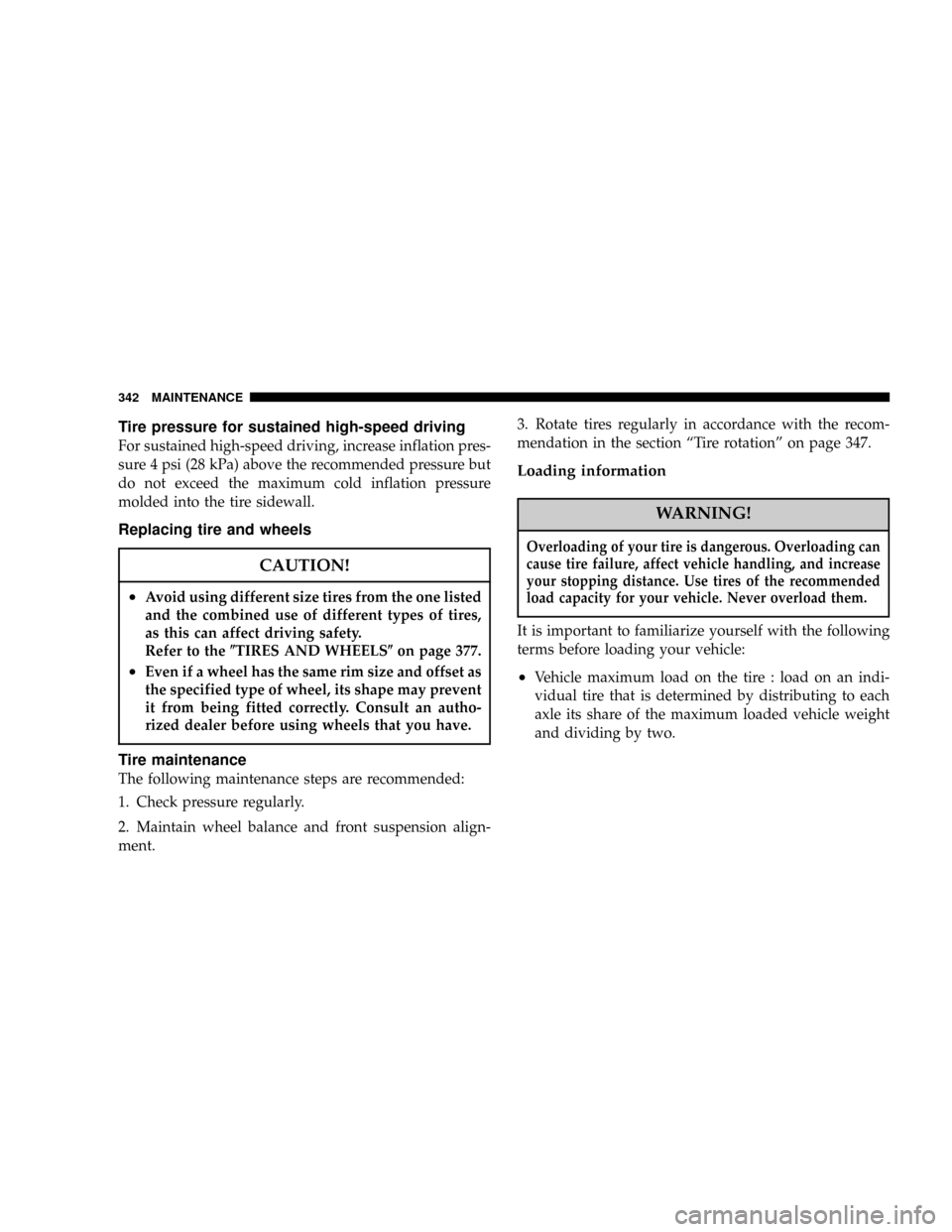2005 DODGE STRATUS COUPE tire pressure
[x] Cancel search: tire pressurePage 336 of 396

Amount of belt deflection
in (mm)
Standard value Used belt New belt
A .27 to .33
(6.9 to 8.5).29 to .33
(7.4 to 8.5).17 to .21
(4.4 to 5.4)
B .46 to .61
(11.8 to 15.5).50 to .57
(12.6 to 14.4).34 to .44
(8.8 to 11.1)
C .43 to .56
(11.0 to 14.3).46 to .52
(11.7 to 13.3).33 to .41
(8.4 to 10.4)
D .33 to .43
(8.5 to 10.9).35 to .40
(9.0 to 10.1).24 to .30
(6.2 to 7.6)
WARNING!
Do not check or touch the drive belt with the engine
running, or serious injury may result.
TIMING BELT
The timing belt should be replaced with a new one at the
mileage specified on the scheduled maintenance chart.
TIRES
WARNING!
Driving with tires that are worn or improperly inflated
can result in a collision, and serious or fatal injury.
It is important to familiarize yourself with the following
terms:
·Cold tire pressure:
1. The measured pressure after the vehicle has been
parked for at least three hours, or
2. The measured pressure when the vehicle is driven
less than 1 mile (1.6km) after having been parked for
three hours.
·Maximum inflation pressure : the maximum permis-
sible cold tire inflation pressure for this tire
·Recommended inflation pressure : the inflation pres-
sure for optimum tire performance
·Intended outboard sidewall :
1. The sidewall that contains a whitewall, bears white
lettering or bears manufacturer, brand, and/or model
name molding that is higher or deeper than the same
molding on the other sidewall of the tire, or
336 MAINTENANCE
Page 338 of 396

letters9LT9that are molded into the sidewall preceding
the size designation. Example: LT235/85R16.
²Temporary spare tires are high pressure compact
spares designed for temporary emergency use only.
Tires designed to this standard have the letter9T9
molded into the sidewall preceding the size designa-
tion. Example: T145/80D18 103M.
Service Description
EXAMPLE: 95H
95Load index
A numerical code associated with the maximum
load a tire can carry.
HSpeed symbol
A symbol indicating the range of speeds at which
a tire can carry a load corresponding to its load
index under certain operating conditions.
The maximum speed corresponding to the speed
symbol should only be achieved under specified
operating conditions. (i.e. tire pressure, vehicle
loading, road conditions and posted speed limits).
Maximum Load
Maximum load indicates the maximum load this tire is
designed to carry
Maximum Pressure
Maximum Pressure indicates the maximum permissible
cold tire inflation pressure for this tire.
Tire Identification Number (TIN)
The TIN may be found on one or both sides of the tire,
but the date code may only be on one side. Tires with
white sidewalls will have the full TIN including date
code located on the white sidewall side of the tire. Look
for the TIN on the outboard side of black sidewall tires as
mounted on the vehicle. If the TIN is not found on the
outboard side then you will find it on the inboard side of
the tire.
338 MAINTENANCE
Page 340 of 396

Vehicle Safety Standard No. 109. Grades B and A repre-
sent higher levels of performance on the laboratory test
wheel than the minimum required by law.
Tire inflation pressures
Proper tire inflation pressure is essential to the safe and
satisfactory operation of your vehicle. Three primary
areas are affected by improper tire pressure:
1. Safety
Under-inflation increases tire flexing and can result in tire
failure. Over-inflation results in a tire losing its ability to
cushion shock. Objects on the road and potholes could
cause tire damage that may result in tire failure.
2. Economy
Improper inflation pressures can cause uneven wear
patterns to develop across the tire tread. These abnormal
wear patterns will reduce tread life, resulting in a need
for earlier tire replacement.
Under-inflation also increases tire rolling resistance and
results in higher fuel consumption.
3. Ride comfort and vehicle stability
Proper tire inflation pressures contribute to the excellentride quality built into your vehicle. Over-inflation pro-
duces an uncomfortable and jarring ride.
Under-inflation can produce a feeling of sluggish response.
Unequal inflation pressures can produce erratic and
unpredictable vehicle response to steering maneuvers.
The proper tire pressure for your vehicle is listed on a
placard attached near the door sill striker on the driver's
side ``B''-Pillar.
The recommended inflation pressures should be followed
when the specified tires are installed.
Item Tire size Front Rear
Normal tire P205/60R16 91H 32 psi (220 kpa)
P215/50R17 90H 32 psi (220 kpa)
Compact spare tire T125/70D16 60 psi (420 kpa)
The pressures should be checked and adjusted, if neces-
sary, at least once a month.
Tire pressures should be checked more often when weather
temperatures vary widely, because tire pressures vary with
outdoor temperatures. Inflation pressures specified on the
placard are always ªcold inflation pressureº.
Cold inflation pressure can be measured after the vehicle has
been stationary for at least three hours or driven less than
340 MAINTENANCE
Page 341 of 396

one mile (1.6 km) after being stationary for three hours.
Cold inflation pressure must not exceed the maximum
values molded into the tire sidewall. After driving several
miles, tire inflation pressure may increase 2 to 6 psi (14 to 41
kPa) over the cold inflation pressure; do NOT let air out of
the tires to match the specified cold pressure, or your tires
will be underinflated.
Check your tires each time you refuel. If one tire looks lower
than the others, check the tire inflation pressure for all of
them. The following precautions also should be observed:
1. Keep your tires inflated to the pressures that are
recommended. (See the tire and loading information
placard attached the driver's side ``B''-Pillar.)
2. Stay within the load limits that are recommended.
3. Make sure that the weight of your vehicle load is
evenly distributed.
4. Drive at safe speeds.
5. After the tire inflation pressure has been adjusted,
check the tires for damage and air leaks. Be sure to
replace the rubber caps on the valve stems.
Radial ply tires
Radial ply tires provide improved tread life, road hazard
resistance and smoother high speed ride. The radial ply
factory-installed tires on this vehicle are of belted con-
struction and are selected to complement the ride and
handling characteristics of your vehicle.
Radial ply tires have the same load carrying capacity as
bias or bias-belted tires of the same letter size, and use the
same recommended inflation pressures.
Mixing of radial ply tires with bias or bias-belted tires is
not recommended. Combining radial ply and bias or
bias-belted tires on one vehicle will negatively affect
vehicle handling. It is recommended that radial ply tires
should always be used as a set of four.
As longer wearing tires can be more susceptible to
irregular tread wear, it is very important to follow the tire
rotation interval shown in the section ªTire rotationº to
achieve full tread life potential in these tires.
Cuts and punctures in radial ply tires are repairable only
in the tread area, because of sidewall flexing. Consult
your tire dealer for radial ply tire repairs.
MAINTENANCE 341
9
Page 342 of 396

Tire pressure for sustained high-speed driving
For sustained high-speed driving, increase inflation pres-
sure 4 psi (28 kPa) above the recommended pressure but
do not exceed the maximum cold inflation pressure
molded into the tire sidewall.
Replacing tire and wheels
CAUTION!
²Avoid using different size tires from the one listed
and the combined use of different types of tires,
as this can affect driving safety.
Refer to the(TIRES AND WHEELS(on page 377.
²Even if a wheel has the same rim size and offset as
the specified type of wheel, its shape may prevent
it from being fitted correctly. Consult an autho-
rized dealer before using wheels that you have.
Tire maintenance
The following maintenance steps are recommended:
1. Check pressure regularly.
2. Maintain wheel balance and front suspension align-
ment.3. Rotate tires regularly in accordance with the recom-
mendation in the section ªTire rotationº on page 347.
Loading information
WARNING!
Overloading of your tire is dangerous. Overloading can
cause tire failure, affect vehicle handling, and increase
your stopping distance. Use tires of the recommended
load capacity for your vehicle. Never overload them.
It is important to familiarize yourself with the following
terms before loading your vehicle:
²Vehicle maximum load on the tire : load on an indi-
vidual tire that is determined by distributing to each
axle its share of the maximum loaded vehicle weight
and dividing by two.
342 MAINTENANCE
Page 347 of 396

When the indicators appear in two or more adjacent
grooves, tire replacement is recommended.
NOTE: The mark and the location of the tire wear
indicator are different depending on tire manufacturers.
Tire rotation
To equalize wear and help extend tire life, DaimlerChrysler
recommends that you rotate your tires at the mileage speci-
fied on the scheduled maintenance chart.
However, the timing for tire rotation may vary according toyour vehicle condition, road surface conditions and each
individual driver's driving habits. Any time you notice
unusual wear, rotate your tires as soon as possible.
When rotating tires, check for uneven wear, damage and
wheel alignment. Abnormal wear is usually caused by incor-
rect tire pressure, improper wheel alignment, out-of-balance
wheel or severe braking. Consult an authorized dealer to
determine the cause of irregular tread wear.
The first rotation is the most important to achieve more
uniform wear for all tires on the vehicle.
M40A0270
Type 1
M40A0490
Type 2
MAINTENANCE 347
9
Page 348 of 396

CAUTION!
Do not use the compact spare tire for tire rotation.
Tire chains
CAUTION!
Tire chains are not recommended for your vehicle.
The clearance between the chains and the body is
small, and the body might be damaged.
Snow tires
Some areas of the country require the use of snow tires
during winter. Standard tires are of the all season type
and satisfy this requirement as indicated by the M+S
designation on the tire side wall.
If you need snow tires, select tires equivalent in size and
type to the original equipment tires. Failure to do so may
adversely affect the safety and handling of your vehicle.Snow tires should be inflated 4 psi (28 kPa) higher than
the inflation pressure shown on the vehicle's tire placard.
Never inflate over the maximum pressure shown on the
tire sidewall.
Snow tires should not be operated at sustained speeds
over 75 mph (120 km/h).
NOTE: As flange nuts are used on your vehicle, change
to tapered nuts when snow tires (steel wheels) are used.
348 MAINTENANCE
Page 374 of 396

6 - Tire and loading information placard
The tire inflation pressure label is located on the inside
sill of the driver 's door.
7 - Certification label
The certification label is located on the inside sill of the
driver's door.
BATTERY
BCI Group NO.86
Battery is 12 volts.
NOTE: There are various size of the batteries in the BCI
Group No.86.
When you replace a battery, check the size of the battery
to prevent interfering with other parts in the engine
compartment.
B02E0180
B02F0060X
6
7
374 SPECIFICATIONS